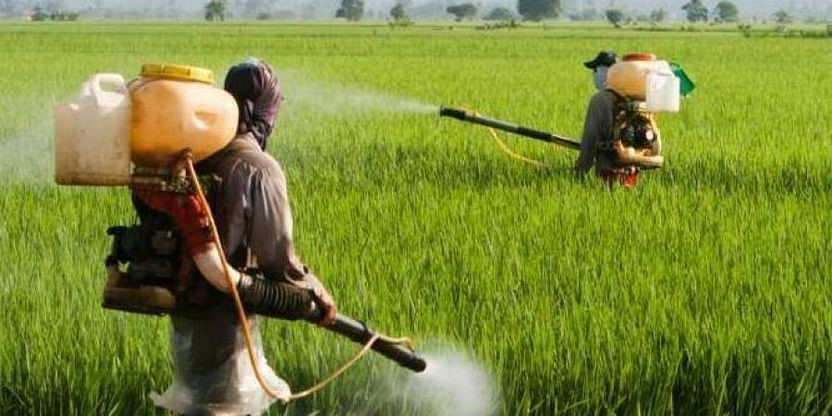
India must trim fertiliser use for fiscal, environmental sustainability: Expert
Fertiliser industry veteran G Ravi Prasad speaks about innovative ways to cut down fertiliser consumption, which is very high in the country at present

India has no other option but to trim its ballooning fertiliser subsidy to enable it to reduce import dependence, for the purpose of fiscal prudence and thirdly, for environmental sustainability of agriculture.
In May, the government provided ₹1.10 lakh-crore for fertiliser subsidy in addition to the budget outlay of ₹1.05 lakh-crore. In all, this year’s provision is 55 per cent higher than last year’s revised budget estimate of ₹1.62 lakh-crore.
India imported 19 million tonnes of fertiliser last year and produced 43 million tonnes. It spent close to $24 billion on imported fertilisers and their inputs. Of the 62 million tonnes of fertiliser consumed, 35 million tonnes or 56 per cent of the total was just one nutrient, that is, urea, which is 46 per cent nitrogen. But nitrogen is only one of the plant nutrients. They also need other nutrients like phosphorous, potassium and sulphur, besides calcium, magnesium, iron, zinc, copper, boron and molybdenum.
It is possible to cap fertiliser consumption at the current level despite the need to grow more food, feed, fuel and fibre to meet the needs of a growing population, G Ravi Prasad said in a Zoom interview with The Federal. Prasad is a fertiliser industry veteran.
Besides heading a company based in Hyderabad that imports, blends, contract manufactures and sells soluble fertilisers, Prasad was the president of Coromandel Fertilisers and vice-president at Zuari Agro Chemicals.

Prasad said fertiliser use can be reduced by improving nitrogen use efficiency. Urea prills when coated with enzymes prevent the release of nitrogen into the atmosphere or leaching into the soil. He said on an average, India’s nitrogen use efficiency is about 40 per cent. This is the lowest in the world among major food producers.
Also read: Overuse of chemical fertilisers causing ill-effects: Shah tells farmers
According to the Fertiliser Association of India (FAI) the world average is above 50 per cent. By using the enzymes, about a fifth of the nitrogen can be saved and made available to plants. This is a saving of 7 million tonnes. At the current landed price of imported urea ($715 per tonne), about $5 billion will be shaved from the import bill.
Coating urea prills with neem oil, a practice that has been mandatory since May 2015 for domestic manufacturers, is not as effective, Prasad said. Neem oil contains a compound which sterilises the area on which it falls and inhibits microbial activity. This prevents urea from being broken down easily.
Urease enzyme and nitrification inhibitors, on the other hand, release nitrogen slowly and steadily. The crop remains greener for longer. The number of urea applications is also reduced. Germany, Prasad said, does not allow the sale of urea without enzyme coats. It would do good for the environment, reduce the cost of cultivation and shrink the import bill.
Alongside, Prasad recommended the use of liquid nano urea, which the cooperative IFFCO is marketing. This is a foliar spray which is better absorbed than nitrogen in urea. Prasad said in a few countries, including Israel, water soluble fertilisers are used. These are either sprayed or delivered to the root zone through micro-irrigation devices. Precise quantities can be delivered and there is little wastage.
Also read: Delayed monsoon, urea shortage may impact kharif crop choices: Survey
Crop diversification
Another strategy to reduce fertiliser use is crop diversification. Instead of producing rice and wheat in excess of domestic need, India should move to the cultivation of millets, pulses and oilseeds. Rice and wheat have replaced millets in people’ diets, though there is a shift as people want to go back to the so-called coarse grains because they are rich in fibre and release energy slowly into the bloodstream.
The consciousness of non-communicable diseases like diabetes is persuading moneyed people to consume millets. When asked whether farmers would grow millets which are lower-yielding than rice and wheat and therefore less profitable, Prasad said their cost of production is also lower. Besides, the government can incentivise their production with higher support prices.
Pulses and oilseeds are legumes. They produce their own nitrogen from the atmosphere and store it in soil as root nodules. They also need less water. While India is short of pulses by about 7-8 per cent, there is an acute shortage of oilseeds because of which India depends heavily on imported palm oil, sunflower oil and soyabean oil. Promotion of the cultivation of these socially-useful crops, as the former chief economic adviser Arvind Subramanian called them, would have a triple impact: reduced water use, lowering of fertiliser consumption and shrinking of imports.
The third option
A third option would not cut fertiliser consumption but reduce import dependence, Prasad said. Lower grade rock phosphate found in Rajasthan can be used to produce superphosphate, which has 16 per cent phosphorous. Currently, India imports phosphoric acid from Morocco which leverages its monopoly to price it very high.
Poultry waste incinerated at very high temperatures leaves a residue which has 14 per cent phosphorous and 17 per cent potassium. The ash from the spent wash of molasses used to heat boilers in distilleries has 16-24 per cent potassium. Composted municipal waste when applied to farm soil can raise the organic carbon content, improving the water retention capacity and providing a micro-ecosystem for beneficial microbes to thrive.
Prasad said the government’s attention was more focussed on making fertiliser available, rather than controlling its use. Distorted pricing does not allow efficient use. Urea is sold for ₹268 a bag of 45 kg against the landed price of ₹2,500. Diammonium phosphate is sold for ₹1,211 a bag of 50 kg against the landed price of ₹4,098. Mureate of potash is sold to farmers for ₹303 a bag of 50 kg; the imported price is ₹3,979.


